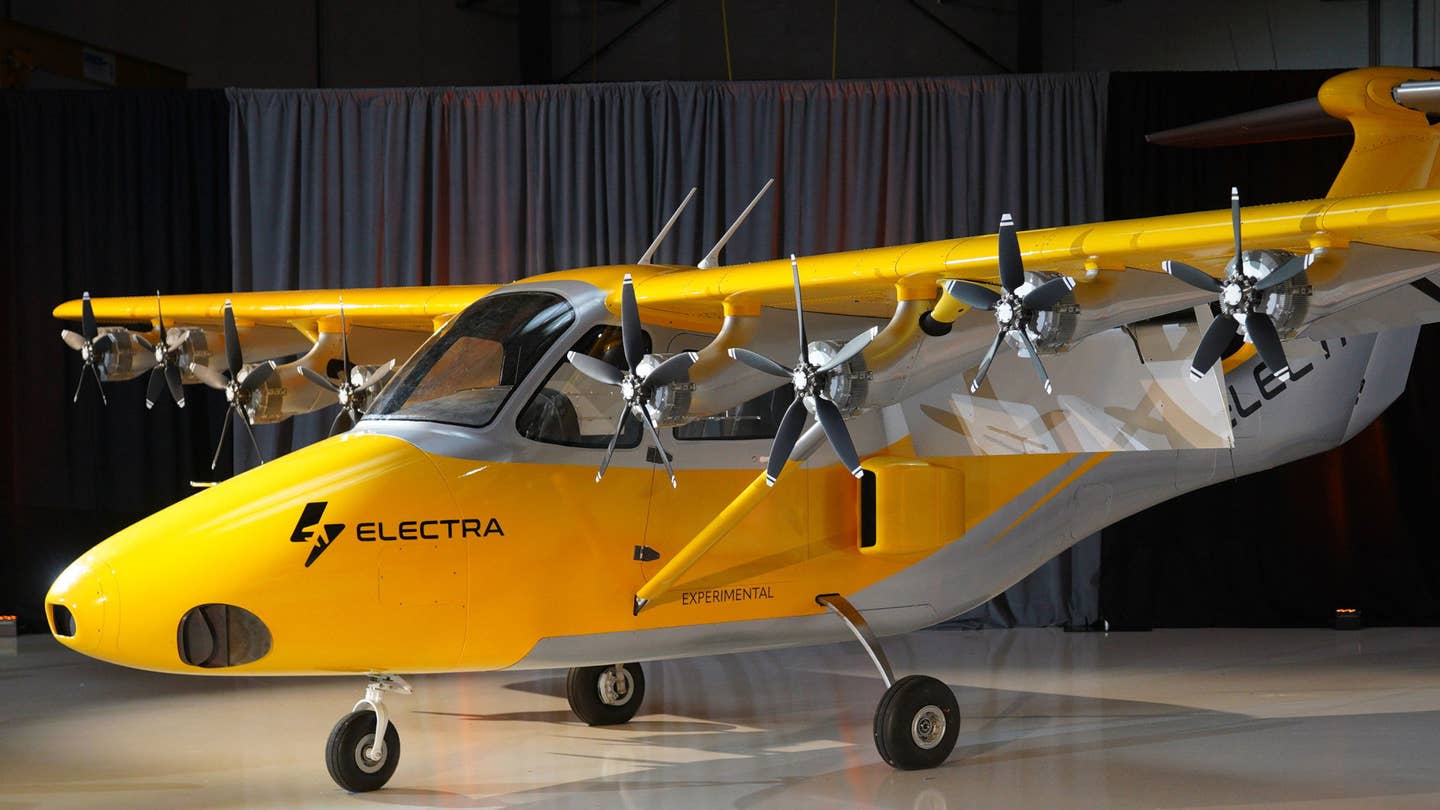eSTOL Aircraft Maker Electra Secures New Investment, Signs Air Force Contract
Funding and agreement will speed development and commercialization of the company’s aircraft, which takes off from runways as short as 150 feet.

Electra’s two-seater eSTOL demonstrator, unveiled in June. [Courtesy: Electra.aero]
As electric short takeoff and landing (eSTOL) aircraft manufacturer Electra.aero works to shorten the runway for others, the startup this week shortened its own runway to launch.
The company last week announced it secured an undisclosed investment from climate technology fund Statkraft Ventures to support the development and commercialization of its production aircraft, which is expected to require just 150 feet of takeoff and landing space.
Statkraft, a venture capital fund focused on sustainable energy transition, is committed to decarbonizing transportation by investing in emerging technologies that reduce emissions and will bolster Electra’s efforts to launch as soon as 2028.
“Statkraft brings a deep commitment to supporting companies and technologies that reduce emissions and address the threat of climate change,” said John Langford, founder and CEO of Electra. “We are honored to have Statkraft on our team and look forward to learning from their insight and experience.”
Concurrently, Electra said it has now signed and fully executed its partnership with the U.S. Air Force’s AFWERX innovation division. The agreement will award the startup a Strategic Funding Increase (STRATFI) worth up to $85 million and support development and testing of its full-scale, preproduction prototype, which the Air Force will use to validate requirements and operational use cases.
The STRATFI deepens Electra’s relationship with Agility Prime, a subdivision of AFWERX dedicated to emerging lift technologies. It also builds on the firm’s six active Air Force Small Business Innovation Research and Small Business Technology Transfer Phase II and III contracts. Those agreements allowed Electra to mature its eSTOL’s hybrid-electric powertrains, blown-lift aerodynamics and acoustics, flight controls, and other features.
In June, Electra unveiled its full-scale, hybrid-electric technology demonstrator, which is expected to begin flying this summer, a year later than originally planned. While the demonstrator features two seats, the company’s full-scale production model will carry up to nine passengers and a pilot, or up to a 2,500-pound payload.
The full-scale design will be built for operations from soccer field-sized spaces. It achieves this through a technology called blown-lift: Eight electric propellers mounted under the leading edge of the aircraft’s fixed wings direct slipstream flows back over the wing into large flaps and ailerons. This directs the flows downward, giving the aircraft enough lift for STOL from runways as short as 150 feet—despite its 9,000-pound weight.
For power, the design’s engine relies on a hybrid-electric powertrain with internal battery-charging capabilities, eliminating the need for ground infrastructure. It is expected to have a 400 nm range and a top cruise speed of 175 knots, creating just 75 dBA of noise when flying at 300 feet—that’s around the volume of a typical vacuum cleaner.
Electra’s aircraft will fly short regional routes in both urban and remote locations, offering a quicker, eco-friendly alternative to road trips. It will occupy the same spaces as vertical takeoff and landing (VTOL) air taxi services such as Joby Aviation and Lilium. But the company claims its aircraft will deliver more than twice the payload and 10 times the range of “vertical alternatives,” while operations will cost 70 percent less.
In addition to passenger transport and on-demand urban air mobility services, the startup expects its aircraft to handle cargo logistics, executive transport, humanitarian aid, disaster response, and a variety of other use cases.
To certify it, Electra is working with the FAA’s Center for Emerging Concepts and Innovation (CECI) and its Atlanta Aircraft Certification Office to define specific plans, checklists, and safety considerations.
But unlike many eVTOL aircraft, Electra’s design has no tilting wings and rotors and no hover or transition phase, charting a simpler path to certification. The goal is to certify it as a multiengine, Level 3, low-speed airplane under FAA Part 23. And to fly it, Electra expects pilots will only need a standard fixed-wing license.
An initial prototype of Electra’s production aircraft is planned to fly in 2025. FAA certification is expected to follow in 2028, two years later than the original target.
“We are excited to partner with Electra as they are leading the change towards more sustainable aviation,” said Alexander Kueppers, managing director at Statkraft. “Their visionary approach and groundbreaking technology to electrify aircraft, reducing operating costs and emissions at the same time, align perfectly with Statkraft Ventures’ mission to support innovative startups that drive the transition to a low-carbon economy.”
The Norwegian venture capital firm’s funding will add to a January 2022 investment by aviation titan Lockheed Martin. Electra has also seen a growing number of preorders, with commitments for over 1,200 deliveries to more than 30 global customers, including existing operators and new entrants.
At launch, Electra has agreements to fly in the Middle East, Asia, Latin America, and Australia, among other locations. It ranked 25th on the most recent AAM Reality Index from SMG Consulting, which assesses the funding, leadership, technology, certification, and production capabilities of AAM manufacturers.
Like this story? We think you'll also like the Future of FLYING newsletter sent every Thursday afternoon. Sign up now.

Subscribe to Our Newsletter
Get the latest FLYING stories delivered directly to your inbox






